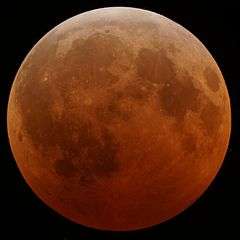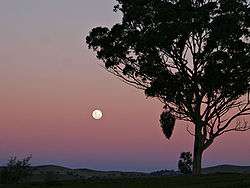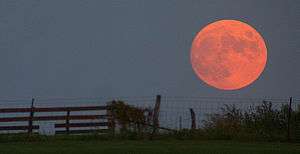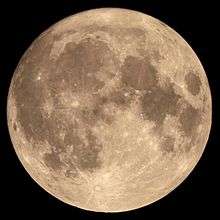Full moon


A full moon is the lunar phase that occurs when the Moon is completely illuminated as seen from Earth. This occurs when Earth is located directly between the Sun and the Moon (more exactly, when the ecliptic longitudes of the Sun and Moon differ by 180 degrees). This means that the hemisphere of the Moon that is facing Earth (the near side) is almost fully illuminated by the Sun and appears round (while the far side is almost completely unilluminated). On some occasions at the time of full moon there is also a lunar eclipse so the moon's face appears reddish due to the rayleigh scattering of blue light in Earth's atmosphere.[3][4][5]
Lunar eclipses can occur only at full moon, where the Moon's orbit allows it to pass through Earth's shadow. Lunar eclipses do not occur every month because the Moon usually passes above or below Earth's shadow (which is mostly restricted to the ecliptic plane). Lunar eclipses can occur only when the full moon occurs near the two nodes of the orbit, either the ascending or descending node. This causes eclipses to only occur about every 6 months, and often 2 weeks before or after a solar eclipse at new moon at the opposite node.
The time interval between similar lunar phases—the synodic month—averages about 29.53 days. Therefore, in those lunar calendars in which each month begins on the new moon, the full moon falls on either the 14th or 15th of the lunar month. Because calendar months have a whole number of days, lunar months may be either 29 or 30 days long.
Characteristics
A full moon is often thought of as an event of a full night's duration. This is somewhat misleading because the Moon seen from Earth is continuously becoming larger and/or smaller (though much too slowly to notice with the naked eye). Its absolute maximum size occurs at the moment expansion has stopped. For any given location, about half of these absolute maximum full moons will be potentially visible, as the other half occur during the day, when the full moon is below the horizon. Many almanacs list full moons not just by date, but by their exact time as well, usually in Coordinated Universal Time (UTC). Typical monthly calendars that include phases of the Moon may be off by one day if intended for use in a different time zone.
Full moons are generally a poor time to conduct astronomical observations, because the bright reflected sunlight from the Moon overwhelms the dimmer light from stars.
On 12 December 2008, the full moon occurred closer to the Earth than it had been at any time for the previous 15 years, called a supermoon.[6]
On 19 March 2011, another super full moon occurred, closer to the Earth than at any time for the previous ~18 years. (cycle)[7]
On 14 November 2016, a super full moon occurred closer to the Earth than at any time for the previous 68 years.[8]
Formula
The date and approximate time of a specific full moon (assuming a circular orbit) can be calculated from the following equation:[9]
where d is the number of days since 1 January 2000 00:00:00 in the Terrestrial Time scale used in astronomical ephemerides; for Universal Time (UT) add the following approximate correction to d:
- days
where N is the number of full moons since the first full moon of 2000. The true time of a full moon may differ from this approximation by up to about 14.5 hours as a result of the non-circularity of the moon's orbit.[10] See New moon for an explanation of the formula and its parameters.
The age and apparent size of the full moon vary in a cycle of just under 14 synodic months, which has been referred to as a full moon cycle.
In folklore and tradition

Full moons are traditionally associated with temporal insomnia (inability to sleep), insanity (hence the terms lunacy and lunatic) and various "magical phenomena" such as lycanthropy. Psychologists, however, have found that there is no strong evidence for effects on human behavior around the time of a full moon.[11] They find that studies are generally not consistent, with some showing a positive effect and others showing a negative effect. In one instance, the 23 December 2000 issue of the British Medical Journal published two studies on dog bite admission to hospitals in England and Australia. The study of the Bradford Royal Infirmary found that dog bites were twice as common during a full moon, whereas the study conducted by the public hospitals in Australia found that they were less likely. All this is relevant to canine rather than human behavior.
Full moon names
Historically, month names are names of moons (lunations, not necessarily full moons) in lunisolar calendars. Since the introduction of the solar Julian calendar in the Roman Empire, and later the Gregorian calendar worldwide, month names have ceased to be perceived as "moon names". The traditional Old English month names were equated with the names of the Julian calendar from an early time (soon after Christianization, according to the testimony of Bede ca. AD 700).
Some full moons have developed new names in modern times, e.g., the blue moon, and the names "harvest moon" and "hunter's moon" for the full moons of autumn.
Harvest and hunter's moons

The "harvest moon" and "hunter's moon" are traditional terms for the full moons occurring during late summer and in the autumn, in the northern hemisphere usually in August, September and October respectively. The "harvest moon" is the full moon closest to the autumnal equinox (22 or 23 September), and the "hunter's moon" is the one following it. The names are recorded from the early 18th century.[13] The Oxford English Dictionary entry for "harvest moon" cites a 1706 reference, and for "hunter's moon" a 1710 edition of The British Apollo, where the term is attributed to "the country people" (The Country People call this the Hunters-Moon.) The names became traditional in American folklore, where they are now often popularly attributed to the Native Americans.[14] The Feast of the Hunters' Moon is a yearly festival in West Lafayette, Indiana, held in late September or early October each year since 1968.[15] In 2010, the Harvest moon occurred on the night of equinox itself (some 5 1⁄2 hours after the point of equinox) for the first time since 1991.[16][17]
All full moons rise around the time of sunset. Because the moon moves eastward among the stars faster than the sun its meridian passage is delayed, causing it to rise later each day – on average by about 50.47 minutes.[18] The harvest moon and hunter's moon are unique because the time difference between moonrises on successive evenings is much shorter than average. The moon rises approximately 30 minutes later from one night to the next, as seen from about 40 degrees N or S latitude. (This is because a full moon in September appears to move not straight east but north-east in the sky.) Thus, there is no long period of darkness between sunset and moonrise for several days following the actual date of the full moon.[19]
Farmers' Almanacs
The Maine Farmers' Almanac from c. the 1930s began to publish Native American "Indian" full moon names. The Farmers' Almanac (since 1955 published in Maine, but not the same publication as the Maine Farmers' Almanac) continues to do so.[20]
An early list of "Indian month names" was published in 1918 by Daniel Carter Beard in his The American Boy's Book of Signs, Signals and Symbols for use by the boy scouts. Beard's "Indian" month names were:[21]
- January: Difficulty, Black Smoke
- February: Raccoon, Bare Spots on the Ground
- March: Wind, Little Grass, Sore-Eye
- April: Ducks, Goose-Eggs
- May: Green Grass, Root-Food
- June: Corn-Planting, Strawberry
- July: Buffalo (Bull), Hot Sun
- August: Harvest, Cow Buffalo
- September: Wild Rice, Red Plum
- October: Leaf-Falling, Nuts
- November: Deer-Mating, Fur-Pelts
- December: Wolves, Big Moon
Such names have gained currency in American folklore. They appear in print more widely outside of the almanac tradition from the 1990s in popular publications about the Moon. Mysteries of the Moon by Patricia Haddock ("Great Mysteries Series", Greenhaven Press, 1992) gave an extensive list of such names along with the individual tribal groups they were supposedly associated with.[22] Haddock supposes that certain "Colonial American" moon names were adopted from Algonquian languages (which were formerly spoken in the territory of New England), while others are based in European tradition (e.g., the Colonial American names for the May moon, "Milk Moon", "Mother's Moon", "Hare Moon" have no parallels in the supposed native names, while the name of November, "Beaver Moon" is supposedly based in the Algonquin).
The individual names given in Farmers' Almanac include:
- January: "Wolf Moon" (this is the name of December in Beard 1918)[23] also "Old Moon"
- February: "Snow Moon", also "Hunger Moon"
- March: "Worm Moon", "Crow Moon", "Sap Moon", "Lenten Moon"
- April: "Seed Moon", "Pink Moon", "Sprouting Grass Moon", "Egg Moon" (c.f. "Goose-Egg" in Beard 1918), "Fish Moon"
- May: "Milk Moon", "Flower Moon", "Corn Planting Moon"
- June: "Mead Moon", "Strawberry Moon" (c.f. Beard 1918), "Rose Moon", "Thunder Moon"
- July: "Hay Moon", "Buck Moon", "Elk Moon", "Thunder Moon"
- August: "Corn Moon", "Sturgeon Moon", "Red Moon", "Green Corn Moon", "Grain Moon"
- September: "Harvest Moon", "Full Corn Moon",
- October: "Hunter's moon", "Blood Moon"/"Sanguine Moon"
- November: "Beaver Moon", "Frosty Moon"
- December: "Oak Moon", "Cold Moon", "Long Night's Moon"
The Long Night's Moon is the last of the year and the closest to the winter solstice.[24]
In June 2016 the so-called "Strawberry Moon" coincided with the Summer solstice for the first time since 1967, and would not return for another 46 years.[25]
Hindu full moon festivals
In Hinduism, most festivals are celebrated on auspicious days. Many of the Hindu festivals are celebrated on days with a full moon at night. Different parts of India celebrate the same day with different names, as listed below:
- Chaitra Purnima - Gudi Padua, Yugadi, Ugadi, Hanuman Jayanti (April 15, 2014)[26]
- Vaishakh Purnima - Narasimh Jayanti, Buddha Jayanthi (May 14, 2014)[27]
- Jyeshtha Purnima - Vat Savitri Vrat Vat Purnima (June 8, 2014)[28]
- Guru Purnima - the full moon of the Ashadh month
- Vyas Purnima - important day for starting education and honoring teachers[28]
- Shravan Purnima - good day for starting Upanayan day, Avani Avittam, Raksha Bandhan- conceptually Onam also comes on this day.
- Bhadrapad Purnima - start of Pitrupaksha, Madhu Purnima
- Ashvin Purnima - Sharad Purnima
- Kartik Poornima - Thrukkarthika
- Margasirsha Purnima - Thiruvathira, Dathatreya Jayanthi
- Pushya Purnima - Thaipusam, Shakambharee Purnima
- Magha Purnima
- Phalguna Purnima - Holi
Lunar and lunisolar calendars

Most pre-modern calendars the world over were lunisolar, combining the solar year with the lunation by means of intercalary months.[31][32] The Julian calendar abandoned this method in favour of a purely solar reckoning while conversely the 7th-century Islamic calendar opted for a purely lunar one.
A continuing lunisolar calendar is in the Hebrew calendar. Evidence of this is noted in the dates of Passover and Easter in Judaism and Christianity, respectively. The date of the Jewish Rosh Hashana and Sukkot festivals along with all other Jewish holidays are dependent on the dates of the new moons.[33]
Intercalary months
In lunisolar calendars, an intercalary month occurs 7 times in the 19 years of the Metonic cycle, or on average every 2.7 years (19/7). In the Hebrew Calendar this is noted with a periodic extra month of Adar in the early spring.
Blue moon
In the modern system of "traditional" full moon names tied to the solstice and equinox points, a supernumerary full moon in such a period is called a blue moon. The term "blue moon" used in this sense may date to as early as the 16th century, but it became well known in the United States due to the Farmers' Almanac (published since 1818).[34]
According to the Farmers' Almanac, a "blue moon" is the third full moon in any period between either solstice and equinox, or between equinox and solstice, (calculated using the mean tropical year), which contains four full moons.[35] These seasons are equal in length, unlike the astronomical ones, which vary in length depending on the Earth's speed in its elliptical orbit round the sun. To compare, in 1983 the equal length seasons began at 1.48 AM on 23 March, 9.15 AM on 22 June, 4.42 PM on 21 September and 12.10 AM on 22 December, while the astronomical seasons began at 4.39 AM on 21 March, 11.09 PM on 21 June, 2.42 PM on 23 September and 10.30 AM on 22 December (all times GMT). Due to a misinterpretation of this definition in the March 1946 Sky & Telescope magazine, "blue moon" has also been used in the sense of "the second full moon in any month which contains two full moons (this usage has been noted as "erroneous" by Sky & Telescope in 1999).[36] According to either definition, "blue moons" occur with the average frequency of intercalary months, seven times in 19 years, the Farmers' Almanac system of "full moon names" effectively defining a lunisolar calendar.
See also
References
- ↑ http://sivertimes.com/super-moon-exceptional-brightest-moon-in-the-sky-of-normandy-monday-november-14/1872
- ↑ http://astrobob.areavoices.com/2016/11/10/moongazers-delight-biggest-supermoon-in-decades-looms-large-sunday-night/
- ↑ Seidelmann, P. Kenneth (2005). "Phases of the Moon". Explanatory Supplement to the Astronomical Almanac. University Science Books. p. 478. ISBN 0-935702-68-7.
They are the times when the excess of the Moon's apparent geocentric ecliptic longitude λM over the Sun's apparent geocentric ecliptic longitude is 0, 90, 180, or 270 ...
- ↑ "Celestial Alignment without Lunar Eclipse; from google (full moon earth block sunlight) result 2".
- ↑ "tiled from the ecliptic by about 5 degrees; from google (full moon earth block sunlight) result 3".
- ↑ Phillips, Tony (9 December 2008). "Biggest Full Moon of the Year". Science@NASA. Retrieved 4 March 2010.
- ↑ Phillips, Tony (16 March 2011). "Super Full Moon". Science@NASA. Retrieved 13 March 2014.
- ↑ Phillips, Tony (14 October 2016). "Super Full Moon". Science@NASA. Retrieved 13 November 2016.
- ↑ Meeus, Jean (1998). "Phases of the Moon". Astronomical Algorithms (2nd ed.). Richmond, Virginia: Willmann-Bell. pp. 349–354. ISBN 0-943396-61-1.
- ↑ Meeus, Jean (2002). "The Duration of the Lunation". More Mathematical Astronomy Morsels. Richmond, Virginia: Willmann-Bell. pp. 19–31. ISBN 0-943396-74-3.
- ↑ "Full Moon Effect On Behavior Minimal, Studies Say". National Geographic News. 6 February 2004.
- ↑
- ↑ see James Ferguson, Astronomy explained upon Sir Isaac Newton's principles,: and made easy to those who have not studied mathematics, 1756, p. 128. "harvest moon" is also the cognate of herbist-mānod, the Old High German name of November recorded in Vita Karoli Magni, ch. 29.
- ↑ Neata, Emil. "The Hunter's Moon". Night Sky Info. Retrieved 29 December 2008.
- ↑ "Feast of the Hunters' Moon". Tippecanoe County Historical Association.
- ↑ Phillips, Tony (22 September 2010). "Watch out for the Super Harvest Moon". NASA Science. Retrieved 13 September 2011.
- ↑ Maddox, Jack (22 September 2010). "Super Harvest Moon: Autumn phenomenon is a rare treat". CNN. Retrieved 13 September 2011.
- ↑ (1440/(29.531)=50.47 minutes)
- ↑ Larry McNish (2007). "RASC Calgary Centre - Sunset and Moonrise". This gives a graph showing the effect as seen from Calgary, for the whole of the year 2007.
- ↑ "Full Moon Names and Their Meanings". Farmers' Almanac. (2007); "Full Moons: What's in a Name?". National Geographic. Retrieved 12 January 2012.
- ↑ Beard 1918, pp. 78–80. "The Indians' Moons naturally vary in the different parts of the country, but by comparing them all and striking an average as near as may be, the moons are reduced to the following"
- ↑ repeated in The Moon Book by Kim Long (1998:102ff.) Also in Llewellyn's 1996 Moon Sign Book (1995).
- ↑ "Wolf Moon" is attributed to the Algonquin by Haddock (1992); the actual Algonquin name for that moon is squochee kesos or "sun has not strength to thaw". The New England historical & genealogical register and antiquarian journal: v. 10 The Sioux do mention wolves in their name for January, which means "when wolves run together". American Indian Moons; they also refer to that moon as the "moon of the strong cold" or "frost in the teepee". Other tribes had different names for the moons. See also Indian Moons, Days & Other Calendar Stuff American Indian Moons
- ↑ Dance, Scott. "'Long Night's Moon' comes on Christmas for first time since 1977," The Baltimore Sun, Wednesday, December 23, 2015.
- ↑
- ↑ http://www.drikpanchang.com/purnima/chaitra/chaitra-purnima-date-time.html?year=2014
- ↑ http://www.drikpanchang.com/purnima/vaishakha/vaishakha-purnima-date-time.html?year=2014
- 1 2 http://www.drikpanchang.com/festivals/guru-purnima/guru-purnima-date-time.html?year=2014
- ↑ Rare Full Moon on Christmas Day, NASA
- ↑ Ask Tom: How unusual is a full moon on Christmas Day?
- ↑ see e.g., Blackburn, Bonnie; et al. (1999). The Oxford Companion to the Year. Oxford University Press. ISBN 0-19-214231-3.
- ↑ Reingold, Edward M.; et al. (2001). Calendrical Calculations: The Millennium Edition. Cambridge University Press. ISBN 0-521-77752-6.
- ↑ Leviticus 23:4-7, 33-35.
- ↑ The saying "once in a blue moon" meaning "very rarely" is recorded since the 1820s. The term "blue moon" is recorded in 1528, in the couplet O churche men are wyly foxes [...] Yf they say the mone is blewe / We must beleve that it is true / Admittynge their interpretacion. (Thomas Wolsey, Rede me and be nott wrothe, for I say no thynge but trothe ed. 1871 p. 114); it isn't clear however if this refers to intercalation.
- ↑ Farmers' Almanac, "What is a blue moon?", 24 August 2009, available at .
- ↑ Sky and Telescope "What's a blue moon?"
External links
| Wikimedia Commons has media related to Full moon. |
